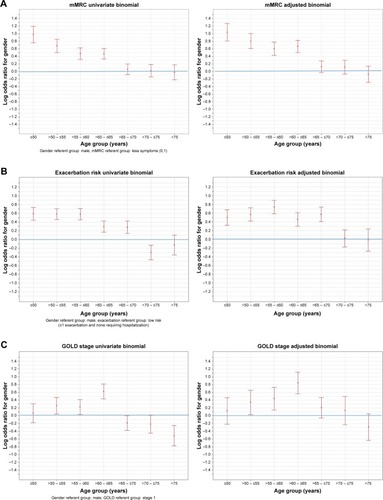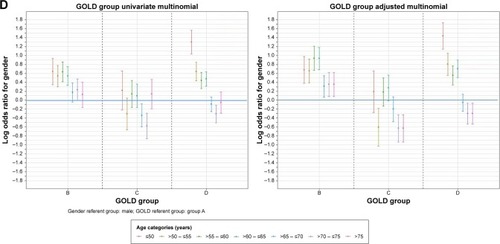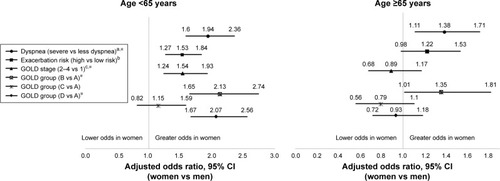Figures & data
Figure 1 Association of gender with dyspnea (A), exacerbation risk (B), GOLD stage (C), and GOLD group (D) in 5-year age increments. (A) Results of the univariate and adjusted binomial logistic regression models describing the association of gender with dyspnea (measured by mMRC) in 5-year age increments. The adjusted models included age, ethnicity, level of education, pack-year smoking history, and current cigarette smoking status (as of 1 month prior to study entry). (B) Results of the univariate and adjusted binomial logistic regression models describing the association of gender with exacerbation risk in 5-year age increments. The adjusted models included age, ethnicity, level of education, pack-year smoking history, and current cigarette smoking status (as of 1 month prior to study entry), current COPD status, FEV1%. (C) Results of the univariate and adjusted binomial logistic regression models describing the association of gender with GOLD stage in 5-year age increments. The adjusted models included age, ethnicity, level of education, pack-year smoking history, current cigarette smoking status (as of 1 month prior to study entry), total emphysema (−950 Hu). (D) Results of the univariate and adjusted binomial logistic regression models describing the association of gender with GOLD group in 5-year age increments. Multinomial model adjusted for age, ethnicity, level of education, pack-year smoking history, current cigarette smoking status (as of 1 month prior to study entry), total emphysema (−950 Hu). Abbreviations: mMRC, modified Medical Research Council; GOLD, Global Initiative for Chronic Obstructive Lung Disease; FEV1, forced expiratory volume in 1 second.


Table 1 Demographic and clinical characteristics of the study population by age and gender (data given as mean [SD] unless stated otherwise)
Figure 2 Adjusted ORs and 95% CIs for the association of female gender with dyspnea, exacerbation risk, GOLD grade, and GOLD group in all participants aged >65 years and ≥65 years. aAdjusted for age, age × gender, race, current cigarette smoking status (as of 1 month ago), FEV1% predicted. Age >65 years: n=2515; Age ≥65 years: n =1956. bAdjusted for age, age × gender, level of education, race, current cigarette smoking status (as of 1 month ago), number of cigarettes smoked per day, FEV1% predicted. Age >65 years: n=2522; Age >65 years: n=1961. cAdjusted for age, age × gender, level of education, race, current cigarette smoking status (as of 1 month ago), number of cigarettes smoked per day. Age >65 years: n=2522; Age >65 years: n=1961. *Age-by-Gender interaction is significant, p<0.05.

